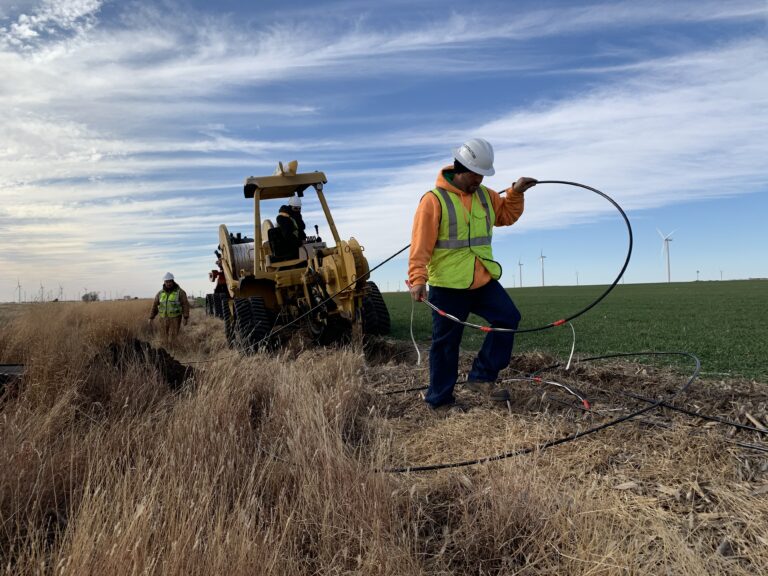Where you live can have a big impact on your internet connection.
More than 20% of Americans in rural areas lack broadband with sufficient speeds, according to a 2020 report from the Federal Communications Commission. That’s compared to just 1.5% of Americans in urban areas.
But there’s an effort to get more broadband resources, including faster internet, to the areas that need it most.
The Bipartisan Infrastructure Law is funding a federal grant program that will distribute $42.5 billion across the country to get all Americans online and tighten the broadband gaps. Each state and territory will get $100 million through the Broadband Equity, Access and Deployment Program, with the remaining funds handed out based on the number of unserved locations in a state.
To help divide up those funds, the FCC created a national broadband map showing where service is and isn’t around the country. The final version will help determine how much funding states will receive for broadband access.
“By painting a more accurate picture of where broadband is and is not, local, state, and federal partners can better work together to ensure no one is left on the wrong side of the digital divide,” said FCC Chairwoman Jessica Rosenworcel in a statement.
Challenging the map
Since mid-November, state and local governments and individual residents have had the opportunity to file a challenge against the map if they feel any information about location or broadband availability is inaccurate. Those challenges are due by Jan. 13.
The Kansas Office of Broadband Development posted a notice online encouraging Kansans to challenge the map. The state’s broadband office says the map shows the state at about 5% unserved, while it’s more likely about 15% unserved.
The office’s director, Jade Piros de Carvalho, said if that’s not fixed, the state can’t do what it needs to.
“It’s not about getting the most amount of money,” she said. “It’s about making sure that the allocation aligns with the need for our state. So if we get much less funding, we’re not going to be able to connect everyone.”

She adds that Kansas is struggling with broadband access in the more sparsely populated areas of the state, and people and communities without adequate broadband access are “left behind,” without the ability to apply for a job, access health care, do homework for school or stream a TV show on Netflix.
“We’re really creating a lack of opportunity for these rural areas if they don’t have the same level of broadband access that is available in more populated areas,” she said.
The Kansas Office of Broadband Development is partnering with the University of Kansas on filing a bulk challenge against the map.
The need
In Missouri, the state’s Office of Broadband Development estimates about 400,000 homes and businesses either have limited access to high speed internet or no access at all.
Director BJ Tanksley said it’s about a “$2 billion problem” if a provider were to try to build a system to connect all of those locations to the internet.
But his office didn’t find major inaccuracies with the FCC’s map. Tanksley said the funding Missouri gets will be used to expand broadband service across the state.
“Priority number one is bringing service to unserved locations,” he said. “Priority two is bringing it to underserved locations. And then it goes beyond that also, you know, addressing digital equity concerns and things like that.”
The COVID pandemic highlighted a need for better broadband, as children relied on internet access for virtual schooling and homework, and people sought access to telehealth.
Tanksley said some people were able to continue their everyday activities on the internet from the comfort of their own home, while others who had slower or no broadband access had to drive to the nearest town or a McDonald’s parking lot to access the internet.
“We want people to be able to live wherever they choose to live and not have to make that decision based solely off of what service may be available,” he said.
Better maps
Broadband providers, experts and offices have praised the FCC’s latest map for using address-level reporting for the data, versus census-block level reporting that it had used in the past.
Whitney Zahnd, a University of Iowa health management and policy professor and the deputy director for the Rural Policy Research Institute Center for Rural Health Policy Analysis, said the FCC had previously faced criticism for census-level reporting “overestimating” broadband access across the country.
“In the past, those maps have indicated if you have one connection in a census block, which is this very small geographic area at the sub-county level, then that whole census block is seen to have broadband access,” she said.
Broadband providers were tasked with providing data for the maps.
Stratford Communications, a small service provider that provides fiber-based internet and fiber-based telephone to about 2,000 customers in central Iowa, was asked last summer to provide address-level data to the FCC.
General Manager Steven Frey called the map “more navigable than anything [the FCC] had prior.” He said he found very few discrepancies with his company’s coverage area on the map. Overall, he said, the map is much improved from the past, and it helps provide a picture of the state of broadband to providers and customers.
Though the current map is an improvement on past ones, Zahnd said it doesn’t show how much broadband costs at each location.
“I think a couple key things we think about access to anything, whether it’s broadband or health care, it’s not solely is it available, but is it affordable? And is it high quality?” she said.
Zahnd said it’s important to challenge any of the map’s inaccuracies so residents can get reliable and affordable broadband access. The funding amounts could be announced this summer.
This story was produced in partnership with Harvest Public Media, a collaboration of public media newsrooms in the Midwest. It reports on food systems, agriculture and rural issues.

